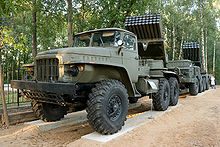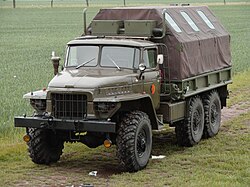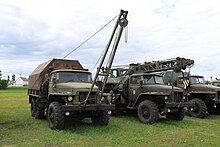Urals-375
| URAL | |
|---|---|
|
Ural-375D of the NVA as a workshop vehicle
|
|
| Urals-375 | |
| Manufacturer: | Uralsky Avtomobilny Zavod |
| Sales designation: | Урал-375 |
| Production period: | 1960 / 61-1993 |
| Previous model: | UralZIS-355M |
| Successor: | Urals-4320 |
| Technical specifications | |
| Engines: | V8 petrol engine |
| Power: | 128-132 kW |
| Payload: | 5 t |
| Perm. Total weight: | 13.2 t |
The Ural-375 ( Russian Урал-375 ) is a four-wheel drive Soviet truck in hood handlebar design with the drive formula 6 × 6, which was manufactured in the Uralsky Avtomobilny Zavod . It was widespread in the Comecon area and located below the KrAZ-255 . The vehicle was built in various variants, the best known, the Ural-375D , also came to the East German NVA in large numbers .
Vehicle history

The first ideas for the development of a military truck with a strong off-road capability came up in the Soviet Union as early as 1953. At that time, the Ministry of Defense formulated a number of criteria that the new vehicle had to meet. These were given to the vehicle construction institute NAMI in Moscow with the task of developing corresponding test samples. The aim was also to close the gap between the smaller ZIS-151 and the larger JaAZ-214 or KrAZ-214 .
The NAMI-020 was then built under the direction of the engineer MI Korotonoschko until 1956. In fact, a whole family of trucks was designed, with models with two ( drive formula 4 × 4), three (6 × 4 and 6 × 6) and four axles (8 × 4 and 8 × 8). In the end, only the version with three axes was approved for mass production.
The extensive testing of the test vehicles had been completed by 1958. All documents and functional models went to the Uralsky Avtomobilny Zavod imeni Stalina (from 1961 Uralsky Avtomobilny Zavod ), where final work was completed. In particular, the tires used were enlarged and minor modifications were made to the all-wheel drive. The vehicle was also given its final designation: Ural-375. In the spring of 1959, further tests were carried out with the revised prototypes, with Ural-375T vehicles also being produced. These were suitable for air transport by the military with a folding windshield and completely foldable side walls.
Series production of the trucks began in November 1960, with the first ten complete vehicles leaving the factory on January 31, 1961. NAMI also checked these trucks in detail and later confirmed that all the planned requirements for the design were met. Until 1964, only Ural-375 vehicles were built that still had a canvas roof as a roof. From this year the Ural-375D went into series production, the driver's cab is made entirely of metal. Around the same time, the Ural-377, a civil version without all-wheel drive appeared. Right from the start, these were equipped ex works for use in Siberia and other remote regions exclusively with an orange painted driver's cab in order to be able to better locate vehicles from the air. This was vital in the event of breakdowns or accidents far away from civilization.
In 1977, the Ural-4320 appeared, a much more economical successor to the model with a modern diesel engine. Nevertheless, the Ural-375D and the Ural-4320 were built in parallel for many years - the Otto engine offers several advantages over the diesel engine, especially in areas with predominantly very low temperatures.
In 1982, the family of vehicles was revised again to include the Ural-375D. The resulting models were built into the early 1990s, then production was gradually reduced. Since there were bottlenecks in the delivery of diesel engines for the Ural-4320 due to accidents at the engine supplier KAMAZ in 1993, production was stopped a little later than planned. At this point in time, the entire range of models was no longer being built.
Military importance
The Ural-375D was one of the standard vehicles of the Soviet Army and played an important role as a transport vehicle in various other armies of the former Eastern Bloc.
A considerable number of Ural-375 and especially Ural-375D were also found in the National People's Army of the GDR . Since the IFA G5 was no longer produced, the Urals quickly developed into the standard vehicle for many different tasks. The import officially began in 1969, and from 1964 onwards, some Ural-375s of the first version even came to the GDR. From 1965 to 1981 only Ural 375Ds were imported, a total of around 3700 vehicles.
In addition to the standard version with flatbed and tarpaulin, the NVA also ran various special variants, including tank trucks such as the AC-5.5-375 model for 5500 l fuel or the Ural-375S and Ural-377S tractor units .
Model variants
In the more than 30 years in which the Ural-375 was built in series, there have been various versions and prototypes. The list below is not exhaustive.
- Ural-375 - The first version of the vehicle was mass-produced from 1961 to 1965. It differed from the later variants mainly in that the roof of the driver's cab is not made of sheet steel, but of fabric.
- Ural-375A - chassis for box bodies. The frame was lengthened by about 30 centimeters and the spare wheel was moved. In addition, a cable winch and an additional tank were installed.
- Ural-375D - model with a revised cabin. In contrast to the first basic model, the roof is now also made of steel. Built from 1964 to 1982.
- Ural-375DM - Modernized version of the Ural-375D, built from 1982 to 1991. One -piece rims were used, and the lighting system and side walls were revised.
- Ural-375DJu - export version for countries with tropical climates. In particular, electrical lines and seals were used that are particularly suitable for correspondingly hot and humid environments.
- Ural-375E - chassis for box bodies, based on the Ural-375D. To gain more space, the spare wheel was moved under the vehicle.
- Ural-375K - special version for particularly cold locations. The vehicle remains ready for use down to at least −60 ° C. To achieve this, an additional battery, auxiliary heating and double glazing were installed. All rubber parts are particularly frost-resistant, and an additional searchlight has been installed on the roof.
- Ural-375N - Civil version without tire pressure control system and with modified tires. All three side walls of the platform are foldable, the truck was built from 1974 to 1982.
- Ural-375NM - Modernized version of the Ural-375N, built from 1982 to 1991.
- Ural-375S - tractor unit based on the Ural-375 for semi-trailers with a total weight of up to twelve tons. The frame was shortened by 135 mm.
- Ural-375S-K1 - tractor unit based on the Ural-375D. Built from 1974, otherwise similar to the Ural-375S.
- Ural-375SN - tractor unit based on the Ural-375N. Semi-trailers up to 18.4 tonnes can be moved, and still up to 12.5 tonnes off-road. Built from 1974.
- Ural-375T - experimental version for transport by air. Never built in series.
- Ural-375Ju - Based on the Ural-375, for tropical applications. Specially insulated and equipped with the appropriate electrics and seals.
- Ural-377 - version without all-wheel drive and with a payload of 7.5 tons. Built from 1964 or 1965.
- Ural-377S - tractor unit based on the Ural-377. About 30 of them found their way to the NVA.
In addition, there are various special structures, for example as a crane, earth drill, municipal vehicle, fire engine, tanker, log transporter, flatbed truck, airfield vehicle, oil field vehicle and with heavy snow blowers of the type D-902 . The chassis of the Ural-375 formed the basis of the Chinese Shaanxi SX250 truck model .
technology


All of the following technical information and data refer to the Ural-375D model from around 1966.
| length | 7350 mm |
| width | 2690 mm |
| height | 2980 mm |
| wheelbase | 3500 + 1400 mm |
| Empty weight of the chassis with winch | at least 8400 kg (plus body) |
| payload | 4800 kg |
| Permitted trailer load | 10,000 kg |
| Permissible total mass | 13,200 kg |
| Top speed, fully loaded | 75 km / h |
| Fuel supply | 300 l + 60 l optional |
| Middle driving range including reserve | 500-550 km |
| Average fuel consumption | 45-50 l / 100 km |
| frame | riveted side and cross members |
| Hitching devices | two rigid towing hooks at the front, buffered hitch at the rear |
| Tires | Tubular tire 14.00-20 for adjustable air pressure |
| rim | three-part, 10-20 |
| Tire pressure, adjustable from ... to | 0.5-3.2 kgf / cm 2 |
| Gradeability at full mass | 30 ° |
| Minimum turning circle | 21 m |
| Fording depth | 1.5 m |
engine
A V8 four-stroke gasoline engine serves as the engine. Prototypes received an engine of the type ZIL-6E129 (ЗИЛ-6Э129), which draws an output of 132 kW from around 7 liters of displacement. A ZIL-375 (ЗИЛ-375) engine was used in the production vehicles. The ZIL-375 differs only slightly from the ZIL-6E129 in that it has a different carburetor and a different engine setting; the ZIL-375 has the same rated output of 132 kW (180 hp), but is much more flexible. In the NVA (National People's Army) the engines were throttled to a maximum output of 128 kW (175 HP). The engine has been optimized for maximum speed flexibility and consumes around 45 liters per 100 kilometers on the road at a constant speed of 60 km / h. Off-road fuel consumption can roughly double, with reduction, higher speeds and lower gears being used here.
| Engine type | ZIL-375 |
|---|---|
| design type | Eight-cylinder four-stroke petrol, liquid-cooled |
| Mixture preparation | Quadruple carburetor type K-89A |
| Approved fuel | Carburettor fuel with at least 76 octane |
| Design | 90 ° V eight-cylinder |
| rated capacity | 132 kW (180 hp) at 3200 min -1 |
| Total displacement | 6959 cm 3 |
| Bore × stroke | 108 × 95 mm |
| Compression ratio | 6.5: 1 |
| Highest torque | 466 N · m at 1800 min -1 |
| Lowest specific fuel consumption | 326.4 g / kWh (240 g / PSh) |
| Lowest idle speed | 400-500 min -1 |
| Highest continuous speed | 3000 min -1 |
| Firing order, overall engine | 1-5-4-2-6-3-7-8 |
| Cylinder sequence cylinder bank left | 1-2-3-4 |
| Cylinder sequence cylinder bank on the right | 5-6-7-8 |
| Direction of rotation of the crankshaft | right |
| Oil pressure when the engine is at operating temperature | 1 to 5.5 bar |
| Valve control | OHV, two valves per cylinder |
| Lubrication system | Pressure circulation / spray oil |
| Fuel delivery | Diaphragm pump |
| Fuel filter | two-stage coarse / fine with water separator |
The same engine was also installed in the much heavier ZIL-135 . However, the vehicle used two of the engines. Two ZIL-375 engines were also installed in the ZIL-E167 experimental vehicle , which, just like in the ZIL-135, drive the wheels on the left and right sides.
Gearbox and power transmission
The Ural-375D has three rigid , permanently driven axles with large individual tires and a transfer case that can be locked and reduced. The high off-road mobility is achieved through the typical tires with a tractor profile and the tire pressure that can be changed while driving. The truck has a manual five-speed gearbox and a downstream transfer case with two gears. This means that there are effectively ten gears available. All three axes are permanently driven. They are suspended on leaf springs, at the back as a bogie double axle , i.e. the leaf springs are rotatably mounted in the middle and the axles are attached to the ends.
| Drive concept, drive formula | permanent all-wheel drive, 6 × 6 |
| coupling | Two-disc dry clutch |
| Change gear | JaMZ -204U, mechanical, five gears + reverse gear, 1st gear unsynchronized |
| Translations | 5.62 / 2.89 / 1.64 / 1.00 / 0.724 / R = 5.3 |
| Transfer case | mechanical, two-speed, lockable |
| Translation road / terrain | 1.3 / 2.15 |
| Torque distribution FA: HA | 1: 2 |
| Cardan shafts | open, needle-bearing |
| Axle drive | two-stage gear, without lock |
| Total transmission of the axles | 8.90 |
Electrical system
In order to achieve high off-road mobility, it was necessary, among other things, to design parts of the electrical system to be watertight. Some versions also use special cables that can withstand extreme heat or cold.
| wiring | Discharger, minus ground |
| Operating voltage | 12 V |
| generator | waterproof, alternating current, 40 A. |
| Voltage regulation | electronic semiconductor regulator, contactless |
| Batteries | 12 V, 140 Ah |
| Engine starter | 80 A with magnetic switch |
| Headlights | H4 halogen 55/65 watt, waterproof |
Special equipment
Upon request and at an additional cost, the Ural-375D could be equipped with various additional technology. This included in particular a cable winch attached to the rear, which was driven by the vehicle's engine via a branch gear. With a rope length of 65 m and a rope thickness of 17.5 mm, it was able to apply a maximum force of 70 kN. This corresponds to a freely liftable load of almost seven tons. The branch transmission could also be purchased individually, 40% of the engine output could be taken from it.
The additional equipment also included a 60-liter additional tank, hydraulics for lowering the spare wheel, a heater for the driver's cab and additional seals for various drive components for deep water passages. In addition, a gasoline-powered engine heater with 17 kilowatts of power could be ordered, which acts on the coolant and engine oil. This means that the vehicle remains ready to start even at extremely low temperatures.
literature
- Ralf Kunkel: Type compass. GDR trucks. Imports from the USSR. Motorbuch Verlag Stuttgart, 1st edition 2015, ISBN 978-3-613-03799-1 .
- Uwe Miethe: picture atlas of the GDR road traffic. GeraMond Verlag, Munich 2008, ISBN 978-3-7654-7692-1 .
Individual evidence
- ↑ a b c d e f g Ralf Kunkel: Typenkompass. GDR trucks. Imports from the USSR. P. 46 ff.
- ↑ a b c d e f Detailed website on the Ural-375, especially the Ural-375D, as well as the other model versions of the vehicle (Russian)
- ↑ sinodefence.com: SX2150 Truck (English)
- ↑ a b c d DV-47/24, printed 1966 Ministry of National Defense
- ↑ Основные ТТХ опытного Урал-375 (performance data of the Ural-375 (1959)) (Russian)
- ↑ Энциклопедия по машиностроению XXL - Карбюратор К-75 автомобиля Урал (Mechanical Engineering Encyclopedia XXL - K-75 carburetors in Ural vehicles) (Russian)
- ↑ a b c d e Русская-сила.рф - Урал-375 АРМЕЙСКИЙ АВТОМОБИЛЬ (army vehicle Ural-375) (Russian)









